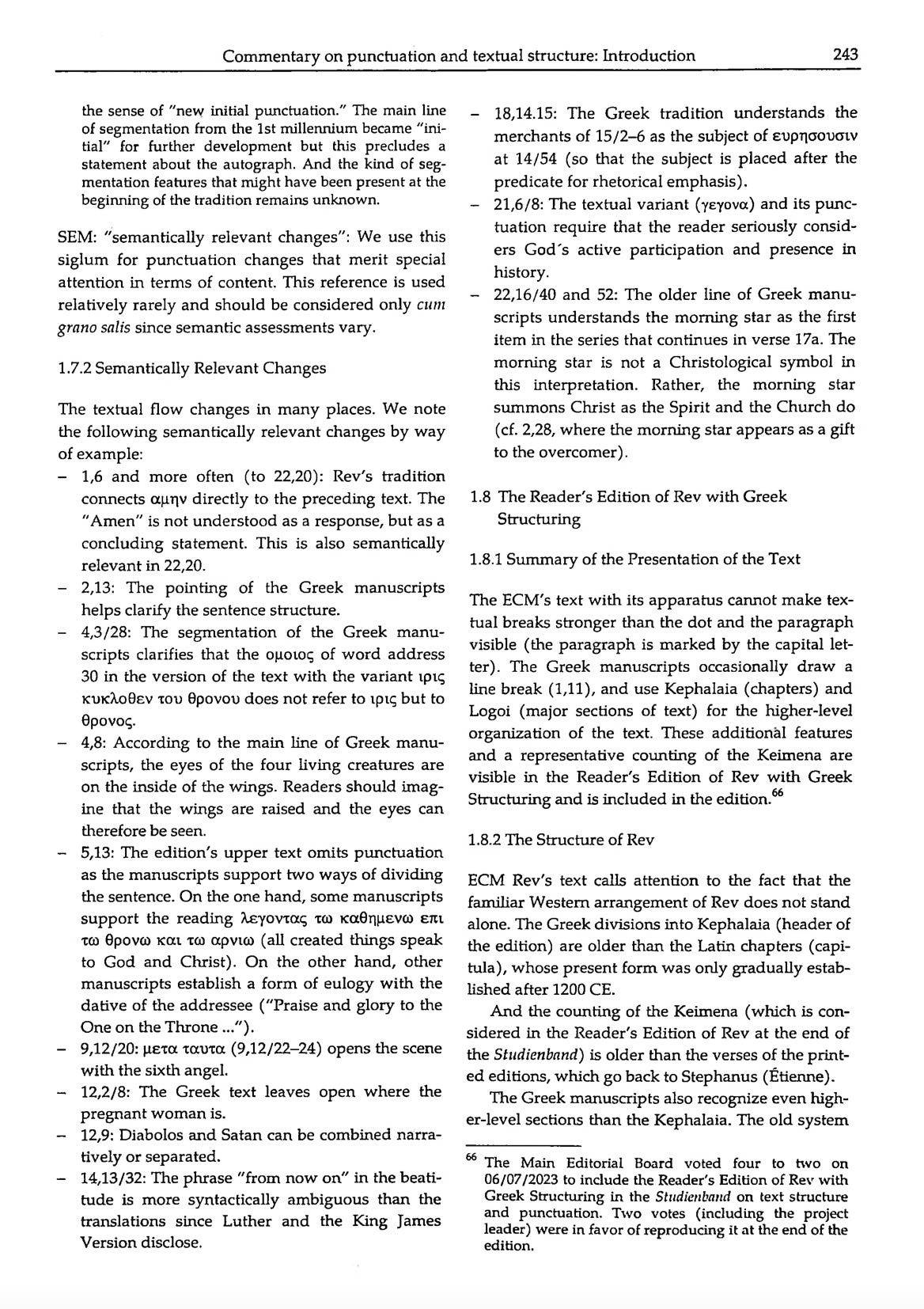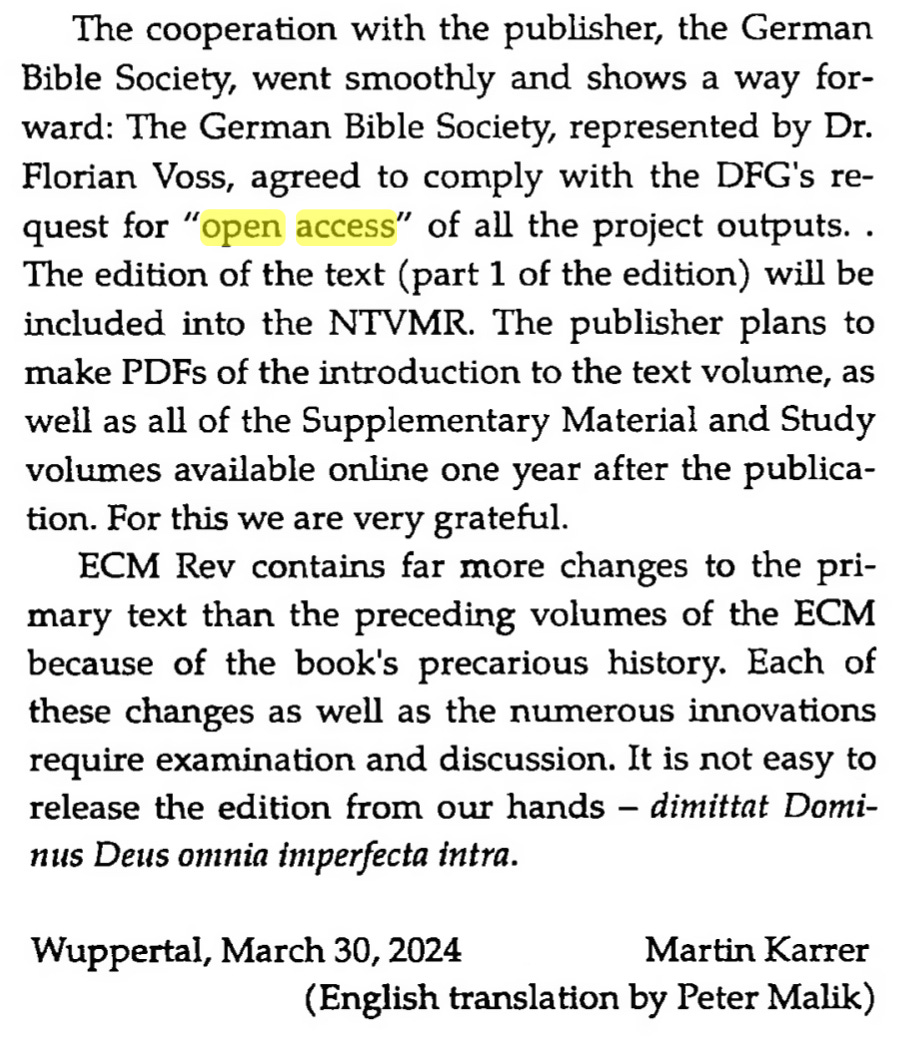The Editio Critica Maior (ECM) of Revelation
An Overview and Initial Review: How much does it change the text of Revelation?
The Editio Critica Maior (ECM) of Revelation is a new, 4-volume edition, replacing Hoskier's exhaustive (at the time) edition from 95 years ago.
Project leader Martin Karrer gave a 90-minute overview at the British New Testament Society (BNTS) meeting on August 23, 2024.
Here’s my summary and takeaways...
(1) During Q&A, Garrick Allen asked Karrer (paraphrased): "What are your hopes and dreams for ECM Revelation in terms of impact?"
His answer was surprising and encouraging to me personally. Karrer said:
My hope and dream is that future New Testaments will restructure the punctuation. I think [punctuation] is the most important innovation [of ECM Revelation]. . . . The most changes [to NA28] are concerning punctuation. And why do I dream of the new punctuation? Punctuation is very important for interpretation.
The punctuation of Revelation in Nestle-Aland 28 is very strange, but you don't see it [until you contrast it with the punctuation of the Greek manuscript tradition].
ECM Revelation introduces 834 places of new/different punctuation when compared to NA28. All of these are discussed in the punctuation commentary in ECM Rev, vol. 3.2 (p. 242 gives the statistics). And a punctuation apparatus drawn from Greek manuscripts is provided below the textual apparatus, so that users can evaluate the punctuation decisions of the editors.
NOTE: The editions of the UBS Greek NT have provided a punctuation ("discourse segmentation") apparatus, but these have been drawn from punctuation and paragraphing of critical editions and translations, NOT from Greek manuscripts.
ECM Rev, vol. 3.2, page 243 gives twelve examples of "sementically relevant changes," in other words, punctuation changes that the editors thought significantly affect the meaning/interpretation of the text.
One example is Rev 22:16b: does the phrase, ο αστηρ ο λαμπρος ο πρωινος ("the bright morning star") refer to Jesus, or not? (As made famous in Bach's chorale, "How brightly shines the Morning Star")
ECM Rev's new punctuation has "bright morning star" belong with the two subjects in v. 17 ("The bright morning star and the Spirit and the bride say, 'Come.'"). Thus "bright morning star" is not a description of Jesus, but a separate individual/thing.
Based on the similar expression in Rev 2:28, Karrer writes:
We can think of the morning star as a symbol of heavenly power and dominion. The morning star calls to Christ as the first star of the heavenly host. . . . the morning star, symbol of the stars between the first and the new heavens, together with the spirit and the bride (the heavenly Jerusalem), calls for Jesus to come
ECM Revelation, vol. 3.2, p. 367.
(2) ECM Revelation introduces the following changes:
84 "new initial readings" (NIR)
106 "split guiding lines" (SGL)
81 places of "new initial orthography" (NIO)
Cites the readings of modern editions from Erasmus onwards since these modern editions often introduced readings not found in any Greek mss, and these readings entered into translations
Provides a full listing of the ancient chapter system (κεφαλαια) integrated alongside the main text in vol. 1, and with the titles given in vol. 3.2
The nomina sacra are printed at 255 locations covering a wide range of words: ανθρωπος, δαυιδ, θεος, ιερουσαλημ, ιησους, ισραηλ, κυριος, μητηρ, ουρανος, πατηρ, πνευμα, πνευματικως, υιος, υιος ανθρωπου, χριστος. (see ECM Rev, vol. 1, pages 47*-59*)
During his presentation, Karrer drew attention to a few of these that seemed most important to him:
2.1 Significant New initial readings (according to Karrer)
2.1.1 ECM Rev omits Rev 20:5a
Rev 20:5a has 11 words: οι λοιποι των νεκρων ουκ εζησαν αχρι τελεσθη τα χιλια ετη ("the rest of the dead did not come to life until the 1,000 years ended"), but ECM Revelation considers these words to be an interpretive gloss, and thus removed it from the initial/original text.
This is less radical than I initially thought; it is somewhat implicit in the resurrection of the martyrs (20:4) that not everyone is resurrected yet, so if 20:5a is an interpolation/interpretive gloss, it just makes more explicit what was implicit in 20:4.
2.1.2 ECM Rev changes the reading at Rev 21:6:
I have discussed this elsewhere with lots of responses.
NA28 reads:
γεγοναν. εγω [ειμι] το α και το ω
"It is finished. I am the Alpha and the Omega"
ECM reads:
γεγονα εγω το α και το ω
"I have become the Alpha and the Omega"
In the punctuation commentary, the editors write that the new reading "contains a nuance of becoming, i.e. of a history in which God confirms what he always already is, the A and O" (ECM Rev, vol. 3.2, p. 356).
In Karrer's slides, he suggested that "The Greek idea of God's immutability influences the [NA28] reading" here at Rev 21:6 in Codex Alexandrinus and Codex Sinaiticus's corrector.
2.1.3 ECM Rev changes the final saying in Rev 22:20:
NA28 reads:
η χαρις του κυριου Ιησου μετα παντων
"The grace of the Lord Jesus be with everyone"
ECM reads:
η χαρις του κυριου Ιησου μετα παντων των αγιων
"The grace of the Lord Jesus be with all the saints"
The universalistic benediction ("with everyone") becomes more particular ("with all the saints"). In Karrer's slides, he suggested that "An optimistic idea of universal grace spreads" in Sinaiticus and the Old Latin reading adopted in NA28.
2.2 Significant New initial orthography/spelling (according to Karrer)
2.2.1 ιερουσαλημ -- smooth or rough breathing?
Following the Greek manuscripts (which the Tyndale House GNT does as well), ECM Rev prints the rough breathing, so ιερουσαλημ is pronounced as Hierusalem, not Jerusalem.
2.2.2 αλληλουια -- smooth or rough breathing?
Following the Greek manuscripts (which the Tyndale House GNT does as well), ECM Rev prints the smooth breathing, so αλληλουια is pronounced as Alleluia, not Hallelujah.
Both the ECM and THGNT editors insist that this may or may not have been the actual pronunciation, but it is what the manuscripts preserve.
(3) The title of "Revelation(s)"?
Karrer had an interesting discussion of the titles of Revelation in Codex Sinaiticus.
"Titles" because there is not one single title in Codex Sinaiticus.
There is: (1) a superscription at the start, (2) a subscription at the end, and (3) running titles throughout the book in the top margins.
Sinaiticus's superscription reads: αποκαλυψις ιωανου (singular "revelation" and John spelled with one nu)
Sinaiticus's running titles read: αποκαλυψεις ιωαννου (plural "revelations" and John spelled with two nu's)
Sinaiticus's subscription reads: αποκαλυψεις ιωαννου (plural "revelations" and John spelled with two nu's)
Karrer doesn't think this is an itacism, but a genuine plural form of αποκαλυψις. And Karrer said: "The plural ἀποκαλύψεις reminds of ἀποκαλύψεις in 2 Cor 12:1; I dare the interpretation: The John of Rev received heavenly 'disclosures' in seeing Christ, God's throne-room and the signs of Rev 6-22."
Shall we scold Sinaiticus' scribe for writing "Revelations"!?
(4) The witness of versions/fathers to variants not found in ECM Revelation.
After Karrer's session, there were papers on the textual criticism of Revelation.
4.1 Erica Leonardi discussed Rev 2:2:
και επειρασας τους λεγοντας εαυτους αποστολους ειναι και ουκ εισιν, και ευρες αυτους ψευδεις ("And you test those who call themselves apostles and are not, and you find them to be liars")
Erica discussed a variant for αποστολους found only in versions, where they substitute "Jews/Hebrews" for apostles, revealing maybe an anti-Jewish bias.
ECM Revelation does not give this evidence since ECM only provides versional evidence if they believe it goes back to a Greek original, i.e. ECM will not provide versional variants that seem to have arisen only in the versions since ECM is focused on the Greek tradition.
This is where Tischendorf still has some value for reception history, since he cites the Armenian version and its reading "Jews/Hebrews" in Rev 2:2.
4.2 Andrea Riccardo Rossi gave a paper on patristic variants in Rev 20:1-10 which are not cited in ECM Revelation.
Andrea looked to pre-4th century patristic evidence to discover a variant at Rev 20:7: "after the seven-thousandth year" -- perhaps adding the number 7 to highlight the perfect/complete nature of a 7,000 year kingdom.
(5) The Nestle-Aland 29/UBS6 committee is not bound to adopt all of ECM Revelation's changes.
NA29/UBS6 are likely to adopt the 84 textual changes and 106 split guiding lines. But Karrer said they are hesitant to adopt ECM Revelation's new punctuation and use of nomina sacra. These new features are not found in the other ECM editions and will not be in other future ECM editions, so adding them would complicate NA29/UBS6.
Just FYI -- Nestle-Aland 29 and UBS6 will be edited by scholars from the INTF in Münster, Germany (Holger Strutwolf, Klaus Wachtel); from Birmingham, UK (David Parker, Hugh Houghton), as well as an Eastern Orthodox scholar (Christos Karakolis) and Roman Catholic scholar (Stephen Pisano, who passed away in 2019, so not sure how that works 🧐 but he is still listed as an editor), and representatives of the German Bible Society (Florian Voss) and United Bible Societies (Edgar Ebojo).
Martin Karrer and his ECM Revelation team were a separate editorial team working in Wuppertal, Germany, and Karrer is not part of the NA29/UBS6 editorial committee, so Karrer can't really control what the NA29 committee does and does not use from ECM Revelation.
CONCLUSION:
ECM Revelation provides all the material needed not only to reconstruct the text and textual history of Revelation; it also provides the data needed to reconstruct how Revelation was structured at the macro level into chapters/paragraphs, how it was punctuated, and even how it was pronounced with new spellings/accents/breathing marks.
P.S. Martin Karrer has a journal article on ECM Revelation to be published with Theologische Literaturzeitung (ThLZ) soon. It is entitled, “Die Editio Critica Maior der Apokalypse und ihre Innovationen.”
P.P.S. At the request of those who funded the project, parts of ECM Revelation will become OPEN ACCESS after one year! (~July 2025?)




